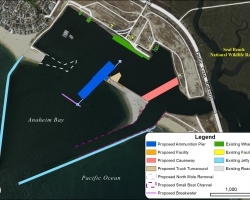
The primary role of the Seal Beach Naval Weapons Station is to store and maintain weapons for the Navy’s Pacific Fleet surface ships.
An ambitious plan is in the beginning stages to build a replacement ammunition pier, waterfront facilities, a public navigational channel and turnaround basin. These proposed changes to the existing Anaheim Bay area are now in the Environmental Assessment stage and copies of the draft environmental report can be downloaded at https://SealBeachEA.com/. It is also available at the Mary Wilson Library in Old Town and the Los Alamitos/Rossmoor Library.
The U.S. Navy invites public comment and has scheduled a meeting here for May 16, 2017 from 4-7 p.m. at the Marina Center.
The timing of this project comes as the Navy is moving more ships from the Atlantic Ocean to the Pacific Ocean, and the size of the Navy fleet is increasing, therefore more ships will be coming through the Seal Beach facility.
Weapons Station spokesman Gregg Smith says that the Navy hopes the project will have little adverse impact on Seal Beach or the surrounding environment.
“The Navy has spent the last year analyzing this proposed project’s potential impacts to the community and the environment. We’ve studied everything from geology and beach erosion to view concerns and endangered species.
“The draft Environmental Assessment indicates that, with minimization and conservation efforts employed when necessary, the replacement ammunition pier project would not significantly impact the community or the environment,” Smith said.
Some threatened or endangered species include three birds: the lightfooted Ridgeway’s rail, western snowy plover, and California least tern. The area is also home to the Green Sea Turtle and the Navy would implement noise-reduction measures to not scare the turtles with underwater noise.
Eelgrass would also be threatened during dredging, which could have an impact on the birds, fish and turtles that feed in Anaheim Bay.
New eelgrass beds would be constructed if some are destroyed during dredging.
The current ammunition wharf at the Weapons Station was built during World War II and then reconstructed in 1953. Its condition and capacity fail to meet the Navy’s current needs.
The wharf was built prior to modern day earthquake codes; is too small for large ships; it can’t support unloading two medium-sized ships at the same time; and has security issues due to small civilian boat traffic and cars on Pacific Coast Highway.
Smith hopes the May meeting is well-attended and that people come with questions.
“The Navy is committed to a transparent and thorough environmental review. We believe that public input is critical to ensure that community concerns are taken into account and addressed.
“Once we receive public comments on the draft Environmental Assessment, the Navy will go back to work and spend the next year taking those comments into account and preparing the final Environmental Assessment. A decision on whether or not to proceed with the project will not be made until after all environment documentation is complete,” Smith said.
The next nearest major weapons station port is on Indian Island, Washington, which is 2,400 nautical miles round trip from the fleet bases in San Diego.
If built, the replacement pier would be 1,100 feet by 125-feet long.
The project would include dredging.











